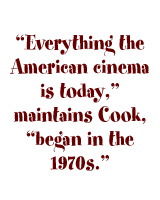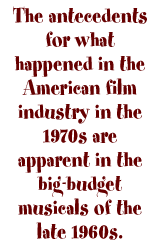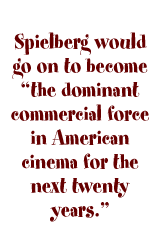WHEN
WALKER PERCY
put the finishing touches to his novel The Moviegoer
in 1961, he had gotten it right: sitting in a darkened movie
theater is just the place for figuring things out. For David
A. Cook, director of Emory’s Film Studies Program, the
same has long been true. Unlike Percy’s protagonist, however,
most of Cook’s revelations concern the movies themselves
and the peculiar brand of alchemy they practice on viewers.
Cook’s
latest project, Lost Illusions: American Cinema in the Shadow
of Watergate and Vietnam, 1970—1979, is simultaneously
a book on 1970s filmmaking and a meditation on an era that has
been, says Cook, “commodified.” Television, for instance,
already has showcased the era with the program That ’70s
Show.
“Most
traffickers in 1970s nostalgia,” asserts Cook, “herald
the new freedom of the youth culture, yet blunt the ramifications
of the Vietnam War.”
 On
the checkerboard of academic life, it was clearly a triple jump
that brought Cook from a 1971 dissertation on the Wessex novels
of John Cowper Powys to the recent contemplation of why early
1970s musicals did poorly at the box office. He arrived at Emory
in 1973 as an assistant professor of English. The climate of
the time dictated that a movie might be one’s entertainment
on a Saturday afternoon, but it was not part of the canon. During
the proving years, Cook joined ranks with his fellow professors
and filled blackboards with evidence of Dante Gabriel Rossetti’s
Asian influences and Vladimir Nabokov’s dark puns. Determined,
nonetheless, that film merited a double bill with literature,
Cook did all in his power to prepare the way for its sustained
study at Emory.
On
the checkerboard of academic life, it was clearly a triple jump
that brought Cook from a 1971 dissertation on the Wessex novels
of John Cowper Powys to the recent contemplation of why early
1970s musicals did poorly at the box office. He arrived at Emory
in 1973 as an assistant professor of English. The climate of
the time dictated that a movie might be one’s entertainment
on a Saturday afternoon, but it was not part of the canon. During
the proving years, Cook joined ranks with his fellow professors
and filled blackboards with evidence of Dante Gabriel Rossetti’s
Asian influences and Vladimir Nabokov’s dark puns. Determined,
nonetheless, that film merited a double bill with literature,
Cook did all in his power to prepare the way for its sustained
study at Emory.
That
day came in 1986, with the creation of the Department of Theater
and Film Studies. In less than six years, the Film Studies Program
stood on its own, offering a graduate-degree program and the
only undergraduate film studies major in the Southeast. Today,
the lights are down and the enthusiasm is up as Cook works alongside
three other full-time professors of film studies to offer everything
from core courses in film theory to electives such as Movie
Censorship and American Culture.
GIVEN
THAT COOK’S OWN GENESIS
as a film scholar began in the 1970s, it is fitting that his
current book project take this decade as its period of study–an
epoch that is, says Cook, “ancient history” to many
of his students.
“Everything
the American cinema is today,” maintains Cook, “began
in the 1970s. It was a decade whose changes were as revolutionary
as the introduction of sound was to cinema in 1928, yet it was
a quieter shift.”
Lost
Illusions not only offers a complete history of a pivotal
decade at the movies, it is also a barometer for who we were–politically
and morally–as Americans in those years.
November
7, 1980–the date of Ronald Reagan’s election–marked
the end to at least two illusions the 1970s had fostered. Cook
describes them with a sense of personal resignation:
The
antecedents for what happened in the American film industry
in the 1970s are apparent in the big-budget musicals of the
late 1960s. Fox’s The Sound of Music in 1965 marked
the crest of the genre’s popularity. Although it seems
impolite to blame Julie Andrews and her sunny ilk, Cook notes
that “the musical entered the 1970s with the onerous distinction
of having helped more than any other single genre to create
the financial crisis of 1969—1971.”
 Overproduced,
big-budget musicals triggered more than $60 million
Overproduced,
big-budget musicals triggered more than $60 million
in losses ($264 million in contemporary terms) for the “majors”
–Paramount, Warner Brothers, Columbia, Fox, Universal,
and MGM/United Artists–between 1967 and 1970. Using Julie
Andrews vehicles as a point of comparison, The Sound of Music
cost around $7 million and grossed $135 million, while Star!
(1968) cost $15 million to make and returned only $4.2 million
in domestic rentals. The recession in the industry triggered
$500 million in losses for the majors, resulted in all-time
lows for weekly audience attendance, and left an estimated 40
percent of Hollywood filmmakers unemployed by 1970.
It
became incumbent upon the industry to imagine a new way to produce
and market its product. From the ashes of such musicals as Star!
arose a defensive production strategy known as “the blockbuster
syndrome.”
In
1971, notes Cook, “185 pictures returned $364 million in
domestic rentals, with fourteen producing 52 percent of this
income, and the remaining 171 left to scramble for the rest.
. . . By this kind of logic, only films that were carefully
packaged and laden with ‘proven’ elements, like pre-sold
properties (best-selling books, hit plays, popular comic strips)
and bankable stars, had a reasonable chance of becoming top-echelon
blockbusters.”
And
what of the character of these blockbusters? Cook writes, “In
marketing and distribution, as well as in production content,
the majors adopted practices . . . that were designed to maximize
profit quickly, regardless of a film’s quality or merit.”
Making an unforgettable splash at the midpoint of the decade
was Universal’s Jaws (1975), a film directed by
Steven Spielberg.
“As
sharks were raised to the level of a national fetish,”
observes Cook, nothing would ever be the same in the way films
were cost-projected and marketed. The great-white-hype was produced
for only $12 million, yet went on to earn $100 million in domestic
rentals in its initial summer run (and $129.5 million overall).
Such singular sensations soon became, paradoxically, the norm.
Jaws was followed in 1977 by George Lucas’s Star
Wars and Spielberg’s Close Encounters of the Third Kind.
Jaws
was, says Cook, the first “high-concept” film—an
industry term denoting a film whose story is easily reducible
to a single image, “which then becomes the basis for an
aggressive advertising campaign keyed to merchandising tie-ins
and ancillary markets, creating ‘synergy’ between
film, products, and related media.”
As
proof of the economic impact of the blockbuster, Jaws
coproducer Richard Zanuck made more money on his share of the
film’s profits in six months than his father, studio executive
Darryl F. Zanuck, had made in his entire career. Twenty-six
at the time Jaws was filmed, Spielberg would go on to
become, in the words of David Cook, “the dominant commercial
force in American cinema for the next twenty years.” With
the creation in 1994 of his own multimedia conglomerate, Dreamworks,
Spielberg packed a bite which rivaled that of any other executive
in the industry.
 DAVID
COOK DID NOT SET OUT to
write a book about the 1970s; his abiding interest was in the
period from 1967 to 1975. For it was then that a phenomenon
quietly took place between the recession and the advent of the
blockbuster: American auteurism. In 1954, French director François
Truffaut would be the first to speak of “la politique des
auteurs” (the policy of authors) to describe the way in
which a film should be a means of personal artistic expression
for its director-writer. Even before a term appeared to describe
the phenomenon, American moviegoers generally had recognized
the special power of directors such as Orson Welles and Alfred
Hitchcock—men who had worked within the studio system yet
had managed to impart a distinctive signature element to their
work.
DAVID
COOK DID NOT SET OUT to
write a book about the 1970s; his abiding interest was in the
period from 1967 to 1975. For it was then that a phenomenon
quietly took place between the recession and the advent of the
blockbuster: American auteurism. In 1954, French director François
Truffaut would be the first to speak of “la politique des
auteurs” (the policy of authors) to describe the way in
which a film should be a means of personal artistic expression
for its director-writer. Even before a term appeared to describe
the phenomenon, American moviegoers generally had recognized
the special power of directors such as Orson Welles and Alfred
Hitchcock—men who had worked within the studio system yet
had managed to impart a distinctive signature element to their
work.
Concurrent
with the economic nadir of the film industry in the late 1960s
was a discovery of the importance of the youth market. For those
aware of the tight controls historically exerted by the studios,
it is refreshing indeed to hear that studio executives jointly
made the remarkable decision to grant artistic control to young
directors in order to capture the youth market. Although their
decision was market-driven, notes Cook, “the studios’
embrace of auteurism represented a genuine attempt to bridge
the generation gap, which brought with it a few years of artistic
freedom and resulted in some of the most original American films
since the late forties.”
Cook
spends an extremely joyful chapter charting the very real inroads
made by the likes of Arthur Penn, Stanley Kubrick, Sam Peckinpah,
Francis Ford Coppola, Martin Scorsese, and Robert Altman. As
with anything in Hollywood, days of innocence are not even twenty-four
hours long. And so it was that what began as “personal”
cinema—Cook cites the ecstatic rebelliousness of films
such as Bonnie and Clyde (Arthur Penn, 1967) or Easy
Rider (Dennis Hopper, 1969)—became, by decade’s
end, corporate and impersonal.
The
auteurs themselves suffered a similar fate, finding celebrity
the equivalent of wearing a mink coat in the middle of a Hollywood
summer. In David Cook’s description, many of them became
“high-rolling celebrity directors . . . with their own
chauffeurs, Lear jets, and body guards.” Sadly, the intoxicating
change wrought by the first wave of auteurs would “boomerang”
on those who followed and, argues Cook, “recast their films
as branded merchandise to be consumed along with T-shirts, action
figures, Happy Meals, and, by the end of the decade, miniaturized
and badly framed versions of the films themselves called ‘videos.’
”
The
other principal joy for Cook in writing Lost Illusions
was the opportunity Emory gave him to build a seminar around
1970s films and his evolving book. Taught in fall 1997, Cinema
of the 1970s gave Cook what he calls “the perfect test-audience.”
Cook considers his time in front of the class valuable in many
senses, but especially so if “the course communicated the
breadth of the cultural phenomenon posed by the blockbuster.”
Cook
chose three notable contributors to add chapters to his volume.
Douglas Gomery, professor of communication arts at the University
of Maryland, wrote the chapter “Motion Picture Exhibition
in 1970s America.” Flanking Gomery’s work is “Looking
Back and Turning Inward: American Documentary Films of the Seventies,”
by William Rothman, a professor in the motion picture program
of the School of Communications at the University of Maryland.
Rounding out the book is the essay “Avant-Garde Cinema
of the Seventies” by Robin Blaetz, author of Visions
of the Maid: Women, War, and Joan of Arc in Twentieth-Century
America.
AFTER
A LONG PERIOD
of immersion in cinema’s past, Cook has emerged with an
interest in the industry’s next step. He predicts that
it will be to make “CGI”–computer-generated imagery–“the
real thing,” by which he means that CGI will be planned
from a film’s beginning rather than being added in postproduction.
The technologies that fall under the rubric CGI make it possible
digitally to integrate photographic images into a film minus
traditional photography.
 Already,
the tireless film historian is chronicling the uses of CGI.
When it was used in Terminator II: Judgment Day in 1992,
Cook reports, CGI consumed a third of the film’s budget.
Currently, however, it often represents a saving for filmmakers,
who no longer must rely on virtuosity to achieve an effect.
Of the many recent uses of CGI, Cook cites a Denzel Washington
film, The Bone Collector, which portrays the gritty realism
of New York City streets without ever entering those mean streets:
all the dramatic exchanges take place in front of a blue screen.
Already,
the tireless film historian is chronicling the uses of CGI.
When it was used in Terminator II: Judgment Day in 1992,
Cook reports, CGI consumed a third of the film’s budget.
Currently, however, it often represents a saving for filmmakers,
who no longer must rely on virtuosity to achieve an effect.
Of the many recent uses of CGI, Cook cites a Denzel Washington
film, The Bone Collector, which portrays the gritty realism
of New York City streets without ever entering those mean streets:
all the dramatic exchanges take place in front of a blue screen.
Cook’s
musings about cinema’s flirtation with the digital domain
will be incorporated into the fourth edition of his ambitious
History of Narrative Film. In circulation since 1981,
this major textbook of film history is in use at approximately
four hundred colleges and universities in North America, the
United Kingdom, and Europe.
Perhaps
the spanning of a decade is a puddle-jump for a historian versed
in limning the history of cinema. Still, the films of the 1970s
are complex, ranging from the bland euphony of Sound of Music
imitators to the disturbing cacophony of Taxi Driver
(1976) as the period progressed. Weathering remarkably strong
tensions within a comparatively short period of time, the 1970s
was both “Hollywood Renaissance,” based on the stirring
aesthetic revival engineered by the young auteurs, and “New
Hollywood,” a haven for dollar-driven cynics. Withal, writes
David Cook, “lies a cinema of great expectations and lost
illusions that mirrored what the historian Peter N. Carroll
has called ‘the tragedy and promise of America in the 1970s.’
”
Susan
M. Carini is director of publications at Emory and a master’s
degree candidate in the film studies program.